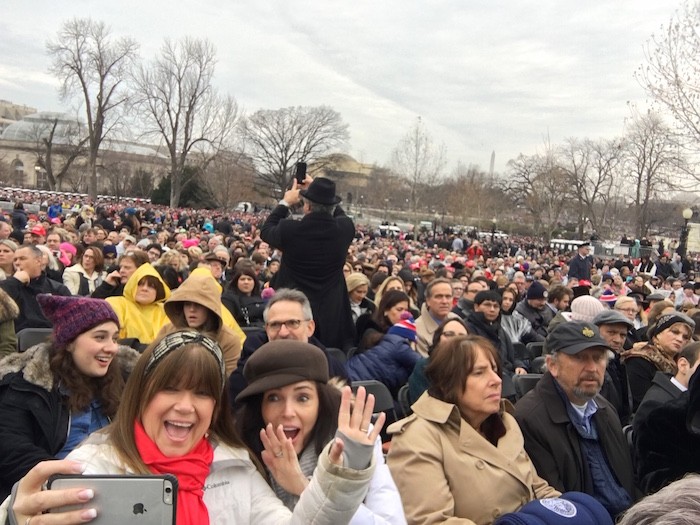
With the red hats, he has created a universal symbol. I’m sure I’m not the first to think this, but it’s overwhelming as I look out at a sea of faces gathered in front of the United States Capitol Building for the inauguration of Donald Trump. The hat has become shorthand for “proud Trump supporter,” for “anti-PC culture,” for “Make America Great Again.”
As I stand southwest of the inauguration stage and look back across the National Mall, there’s a certain distance at which I can no longer make out faces. But I can see the red hats for much farther.
In total, the crowd for Donald Trump’s inauguration was smaller than other recent inaugurations, but the people around me in the cordoned off section for ticket-holding inauguration watchers don't know that. They see an aerial view on the big screen in front of them and cheer. They see Melania Trump and the Trump kids and cheer. They see Hillary Clinton and Barack Obama and boo.
A lone woman in the crowd near me wears a purple pussy hat. She praises Obama, shouting “Yes we can” and “Yes we did,” and she is heckled by two small, fidgety children in bright green jackets. “You’re an idiot,” one of the kids yells at the woman. “You’re a child,” she replies. “Yes,” he says immediately, “but at least I’m smart.” The adults nearby love this.
At one point, as the Obama supporter cheers and shouts, several Trump supporters shout back. One tells her, “You’re in the wrong country.”
“Need a passport?” asks another. She is unfazed.
During these moments of heckling and later, during Trump’s vengeful inaugural address, some of the most enthusiastic shouts and cheers around me are coming from women. They appear almost entirely white and they’re decked out in Trump gear. Presumably, they are part of the 53 percent of white women who voted for Trump.
More than two months after the election and on the day before women are expected to lead a massive anti-Trump march with an intersectional platform, it’s a potent reminder of how many women happily looked past the threat Trump poses to women and helped put him in the White House. They looked past the pussy grabbing, looked past his call to punish women who have abortions, looked past “slob” and “pig” and "dog” and “blood coming out of her wherever,” looked past racism and xenophobia. They either looked past it or they actively welcomed it.

In this moment, as I stand alongside other women waiting for an admitted sexual predator to become president and an evangelical anti-choicer to become vice-president, the calls to empathize and find common ground with Trump supporters feel more hopeless and infuriating than ever. We white women had all the evidence we needed—and more than half of us ignored it. As I look at the women around me and hear them cheer the arrival of Mike Pence and then Donald Trump, I doubt there is any common ground at all to be found between us.
Soon, Trump takes the stage. The lines of his speech that are focused on isolationism and American exceptionalism— “your country,” “America first,” “buy American and hire American”—win huge applause. His mention of “radical Islamic terrorism” is popular, too. When Trump promises America, “We will no longer accept politicians who are all talk and no action, constantly complaining but never doing anything about it,” a woman behind me in a red jacket and American flag scarf shouts, “Thank youuu!”
“You will never be ignored again,” he says, as if he’s answering her directly.
“We will make America proud again,” Trump promises. “We will make America safe again.” And then comes the one they’ve been waiting for. The crowd shouts it along with him: “Make! America! Great! Again!”
Chants break out—“Trump! Trump! Trump!” “USA! USA! USA!”—and then it’s over. I ask the woman in the American flag scarf to talk but she doesn’t want to. Another woman nearby, a broker from New Jersey, tells me she’s been “ignored” and asked to “share my wealth” for the last eight years. When I ask a question about racism, she says it is harder to be white in America today than in the past. “Everyone says white people are bad people,” she says before she’s whisked away by a friend.
I leave and walk among a crush of Trump supporters. We’re corralled by cops, allowed to walk only farther and farther away from what has just happened. Elsewhere, protesters are confronting police. Here, excited Trump fans are celebrating and street vendors are hawking t-shirts that say, “Bitch, I’m the president.” I pass the Belmont-Paul Women’s Equality National Monument. I stop to take a photo and a group passes me on the sidewalk. In the group are two women. They’re both wearing “Make America Great Again” hats.












